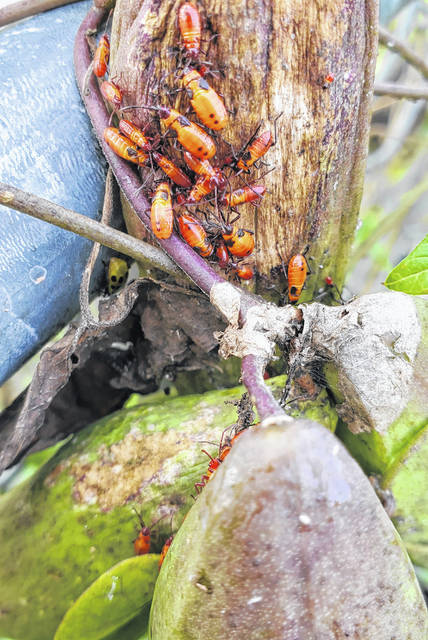
All kinds of bugs and their food sources can be found in Fayette County — including three types of insects that eat Milkweed plants.
According to Brigitte Hisey, the natural resource specialist at Fayette Soil & Water Conservation District, Large Milkweed bugs and Monarch Butterflies eat the Milkweed plant which makes them toxic to most predators.
“The cool thing about Large Milkweed bugs are the color. They are orange and black like the Monarchs. This is a clue for predators not to eat either insect,” wrote Hisey in an email.
In order to eat the Milkweed plant, the Large Milkweed bug has a long proboscis to pierce the seeds, leaves and stems of the milkweed plant, explained Hisey.
A proboscis, according to Amateur Entomologists’ Society website, “is an elongated feeding tube attached to the head of an animal. The most well known example of a proboscis in insects is the feeding tube used by adult butterflies and moths. The proboscis is a tube made by the elongated maxillae of the butterfly, these are u-shaped and held together with hooks to form a tube.”
Speaking of moths, another insect that feeds on milkweed that is orange, black and white is the Milkweed Tussock Moth. According to Hisey, this moth does not taste good to predators, such as bats, because of the Milkweed plant that they consume as instars.
Instars, according to Amateur Entomologists’ Society website, “is the name given to the developmental stage of an arthropod between moults. For example, after hatching from the egg, an insect is said to be in its first instar. When the insect moults, it is then a second instar and so on.”
“All of these insects use milkweed as part of their life cycle and are important to the biodiversity of insects in our county,” explained Hisey. “Milkweed plants are perennials, so they should grow back. If all of the leaves are eaten then the plant has been a great host for a variety of insects.”
All three insects — the Large Milkweed bug, the Monarch Butterfly and the Monarch Tussock Moth — have been found in Fayette County, according to Hisey.
“I have observed a lot of Monarch in the southern part of the county where I live. It is also important for people to know that having fall blooming flowers are important for the Monarch Butterfly as they journey south for the winter. Growing natives like Goldenrod and Asters in your back yard provide a food source,” wrote Hisey.
Hisey further explained that the real test to see how well monarchs did this year will be how many acres the Monarchs inhabit in Mexico during the winter.
“Probably by now, the monarchs we see are going south and not laying eggs on Milkweed plants. Now people should be looking for Monarch roost,” explained Hisey. “If you are lucky, the Monarchs rest at night, and sometimes they come together and may stay on a tree for a couple of days.”
To follow the sightings and tracking of Monarchs by citizen-scientists, Hisey recommends the website www.journeynorth.org/monarchs.
Reach journalist Jennifer Woods at 740-313-0355 or on Twitter @JennMWoods.


